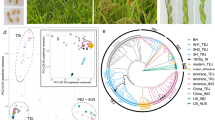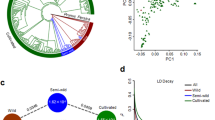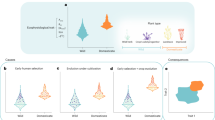Abstract
Vavilovian mimicry is an evolutionary process by which weeds evolve to resemble domesticated crop plants and is thought to be the result of unintentional selection by humans. Unravelling its molecular mechanisms will extend our knowledge of mimicry and contribute to our understanding of the origin and evolution of agricultural weeds, an important component of crop biology. To this end, we compared mimetic and non-mimetic populations of Echinochloa crus-galli from the Yangtze River basin phenotypically and by genome resequencing, and we show that this weed in rice paddies has evolved a small tiller angle, allowing it to phenocopy cultivated rice at the seedling stage. We demonstrate that mimetic lines evolved from the non-mimetic population as recently as 1,000 yr ago and were subject to a genetic bottleneck, and that genomic regions containing 87 putative plant architecture-related genes (including LAZY1, a key gene controlling plant tiller angle) were under selection during the mimicry process. Our data provide genome-level evidence for the action of human selection on Vavilovian mimicry.
This is a preview of subscription content, access via your institution
Access options
Access Nature and 54 other Nature Portfolio journals
Get Nature+, our best-value online-access subscription
$29.99 / 30 days
cancel any time
Subscribe to this journal
Receive 12 digital issues and online access to articles
$119.00 per year
only $9.92 per issue
Buy this article
- Purchase on Springer Link
- Instant access to full article PDF
Prices may be subject to local taxes which are calculated during checkout





Similar content being viewed by others
Data availability
The genomic resequencing and RNA-seq data included in this study were deposited into the BIG data centre (https://bigd.big.ac.cn/) under accession number PRJCA001519.
Code availability
The custom scripts and pipelines used in this study have been deposited in Github (https://github.com/bioinplant/Vavilovian_mimicry).
References
Barrett, S. C. H. Crop mimicry in weeds. Econ. Bot. 37, 255–282 (1983).
Pasteur, G. A classificatory review of mimicry systems. Annu. Rev. Ecol. Syst. 13, 169–199 (1982).
Vavilov, N. I. The origin, variation, immunity and breeding of cultivated plants (translation by K. S. Chester). Chron. Bot. 13, 1–366 (1951).
McElroy, J. S. Vavilovian mimicry: Nikolai Vavilov and his little-known impact on weed science. Weed Sci. 62, 207–216 (2014).
Dasmahapatra, K. K. et al. Butterfly genome reveals promiscuous exchange of mimicry adaptations among species. Nature 487, 94–98 (2012).
Iijima, T. et al. Parallel evolution of batesian mimicry supergene in two Papilio butterflies, P. polytes and P. memnon. Sci. Adv. 4, eaao5416 (2018).
Jay, P. et al. Supergene evolution triggered by the introgression of a chromosomal inversion. Curr. Biol. 28, 1839–1845 (2018).
Kunte, K. et al. doublesex is a mimicry supergene. Nature 507, 229–232 (2014).
Martin, A. et al. Diversification of complex butterfly wing patterns by repeated regulatory evolution of a Wnt ligand. Proc. Natl Acad. Sci. USA 109, 12632–12637 (2012).
Nadeau, N. J. Genes controlling mimetic colour pattern variation in butterflies. Curr. Opin. Insect Sci. 17, 24–31 (2016).
Nadeau, N. J. et al. The gene cortex controls mimicry and crypsis in butterflies and moths. Nature 534, 106–110 (2016).
Nishikawa, H. et al. A genetic mechanism for female-limited Batesian mimicry in Papilio butterfly. Nat. Genet. 47, 405–409 (2015).
Reed, R. D. et al. optix drives the repeated convergent evolution of butterfly wing pattern mimicry. Science 333, 1137–1141 (2011).
Timmermans, M. J. T. N. et al. Comparative genomics of the mimicry switch in Papilio dardanus. Proc. R. Soc. B 281, 20140465 (2014).
Zhang, W., Dasmahapatra, K. K., Mallet, J., Moreira, G. R. P. & Kronforst, M. R. Genome-wide introgression among distantly related Heliconius butterfly species. Genome Biol. 17, 25 (2016).
Gianoli, E. & Carrasco-Urra, F. Leaf mimicry in a climbing plant protects against herbivory. Curr. Biol. 24, 984–987 (2014).
Pannell, J. R. & Farmer, E. E. Mimicry in plants. Curr. Biol. 26, R784–R785 (2016).
Schaefer, H. M. & Ruxton, G. D. Deception in plants: mimicry or perceptual exploitation? Trends Ecol. Evol. 24, 676–685 (2009).
Schluter, P. M. & Schiestl, F. P. Molecular mechanisms of floral mimicry in orchids. Trends Plant Sci. 13, 228–235 (2008).
Barlow, B. A. & Wiens, D. Host-parasite resemblance in Australian mistletoes: case for cryptic mimicry. Evolution 31, 69–84 (1977).
Kellner, A., Ritz, C. M., Schlittenhardt, P. & Hellwig, F. H. Genetic differentiation in the genus Lithops L. (Ruschioideae, Aizoaceae) reveals a high level of convergent evolution and reflects geographic distribution. Plant Biol. 13, 368–380 (2011).
Barrett, S. C. H. & Wilson, B. F. Colonizing ability in the Echinochloa crus-galli complex (barnyard grass). 2. Seed biology. Can. J. Bot. 61, 556–562 (1983).
Barrett, S. C. H. & Wilson, B. F. Colonizing ability in the Echinochloa crus-galli complex (barnyard grass). 1. Variation in life history. Can. J. Bot. 59, 1844–1860 (1981).
Barrett, S. C. H. in Applied Population Biology (eds Jain, S. K. & Botsford, L.) 91–120 (Kluwer Academic, 1992).
Barrett, S. C. H. in Weed Management in Agroecosystems: Ecological Approaches (eds Altieri, M. & Liebman, M. Z.) 57–75 (CRC, 1988).
Tominaga, T. & Fujimoto, T. Awn of darnel (Lolium temulentum L.) as an anthropogenic dispersal organ: a case study in Malo, south-western Ethiopia. Weed Biol. Manage. 4, 218–221 (2004).
Senda, T. & Tominaga, T. Inheritance mode of the awnlessness of darnel (Lolium temulentum L.). Weed Biol. Manage. 3, 46–48 (2003).
Fuller, D. Q. & Stevens, C. J. Open for competition: domesticates, parasitic domesticoids and the agricultural niche. Archaeol. Int. 20, 110–121 (2017).
Guo, L. B. et al. Echinochloa crus-galli genome analysis provides insight into its adaptation and invasiveness as a weed. Nat. Commun. 8, 1031 (2017).
Fuller, D. Q. & Qin, L. Water management and labour in the origins and dispersal of Asian rice. World Archaeol. 41, 88–111 (2009).
Aoki, D. & Yamaguchi, H. Genetic relationship between Echinochloa crus-galli and Echinochloa oryzicola accessions inferred from internal transcribed spacer and chloroplast DNA sequences. Weed Biol. Manage. 8, 233–242 (2008).
Terhorst, J., Kamm, J. A. & Song, Y. S. Robust and scalable inference of population history from hundreds of unphased whole genomes. Nat. Genet. 49, 303–309 (2017).
Li, P. J. et al. LAZY1 controls rice shoot gravitropism through regulating polar auxin transport. Cell Res. 17, 402–410 (2007).
Wang, Y. D., Zhang, T., Wang, R. C. & Zhao, Y. D. Recent advances in auxin research in rice and their implications for crop improvement. J. Exp. Bot. 69, 255–263 (2018).
Strohm, A. K., Baldwin, K. L. & Masson, P. H. Multiple roles for membrane-associated protein trafficking and signaling in gravitropism. Front. Plant Sci. 3, 274 (2012).
Wang, B., Smith, S. M. & Li, J. Y. Genetic regulation of shoot architecture. Annu. Rev. Plant Biol. 69, 437–468 (2018).
Wang, Y. & Li, J. Molecular basis of plant architecture. Annu. Rev. Plant Biol. 59, 253–279 (2008).
Wu, X., Tang, D., Li, M., Wang, K. & Cheng, Z. Loose plant Architecture1, an INDETERMINATE DOMAIN protein involved in shoot gravitropism, regulates plant architecture in rice. Plant Physiol. 161, 317–329 (2013).
Zhang, N. et al. A core regulatory pathway controlling rice tiller angle mediated by the LAZY1-dependent asymmetric distribution of auxin. Plant Cell 30, 1461–1475 (2018).
Hu, X. M. et al. The U-Box E3 ubiquitin ligase TUD1 functions with a heterotrimeric G alpha subunit to regulate brassinosteroid-mediated growth in rice. PLoS Genet. 9, e1003391 (2013).
Qiao, S. L. et al. The RLA1/SMOS1 transcription factor functions with OsBZR1 to regulate brassinosteroid signaling and rice architecture. Plant Cell 29, 292–309 (2017).
Tong, H. N. et al. DWARF AND LOW-TILLERING acts as a direct downstream target of a GSK3/SHAGGY-like kinase to mediate brassinosteroid responses in rice. Plant Cell 24, 2562–2577 (2012).
Yamamuro, C. et al. Loss of function of a rice brassinosteroid insensitive1 homolog prevents internode elongation and bending of the lamina joint. Plant Cell 12, 1591–1605 (2000).
Dong, Z. B. et al. Maize LAZY1 mediates shoot gravitropism and inflorescence development through regulating auxin transport, auxin signaling, and light response. Plant Physiol. 163, 1306–1322 (2013).
Yoshihara, T. & Iino, M. Identification of the gravitropism-related rice gene LAZY1 and elucidation of LAZY1-dependent and -independent gravity signaling pathways. Plant Cell Physiol. 48, 678–688 (2007).
Yoshihara, T., Spalding, E. P. & Iino, M. AtLAZY1 is a signaling component required for gravitropism of the Arabidopsis thaliana inflorescence. Plant J. 74, 267–279 (2013).
You, X. The rice production and farming technique in the Song Dynasty. Chin. J. Rice Sci. 1, 35–41 (1986).
Patel, R. K. & Jain, M. NGS QC toolkit: a toolkit for quality control of next generation sequencing data. PLoS ONE 7, e30619 (2012).
Langmead, B. & Salzberg, S. L. Fast gapped-read alignment with bowtie 2. Nat. Methods 9, 357–359 (2012).
Li, H. et al. The sequence alignment/map format and SAMtools. Bioinformatics 25, 2078–2079 (2009).
McKenna, A. et al. The genome analysis toolkit: a MapReduce framework for analyzing next-generation DNA sequencing data. Genome Res. 20, 1297–1303 (2010).
Cingolani, P. et al. A program for annotating and predicting the effects of single nucleotide polymorphisms, SnpEff: SNPs in the genome of Drosophila melanogaster strainw1118; iso-2; iso-3. Fly 6, 80–92 (2012).
Price, M. N., Dehal, P. S. & Arkin, A. P. FastTree: computing large minimum evolution trees with profiles instead of a distance matrix. Mol. Biol. Evol. 26, 1641–1650 (2009).
Letunic, I. & Bork, P. Interactive tree of life (iTOL) v3: an online tool for the display and annotation of phylogenetic and other trees. Nucleic Acids Res. 44, W242–W245 (2016).
Price, A. L. et al. Principal components analysis corrects for stratification in genome-wide association studies. Nat. Genet. 38, 904–909 (2006).
Li, H. & Durbin, R. Inference of human population history from individual whole-genome sequences. Nature 475, 493–496 (2011).
Molina, J. et al. Molecular evidence for a single evolutionary origin of domesticated rice. Proc. Natl Acad. Sci. USA 108, 8351–8356 (2011).
Danecek, P. et al. The variant call format and VCFtools. Bioinformatics 27, 2156–2158 (2011).
Tajima, F. Statistical-method for testing the neutral mutation hypothesis by DNA polymorphism. Genetics 123, 585–595 (1989).
Browning, S. R. & Browning, B. L. Rapid and accurate haplotype phasing and missing-data inference for whole-genome association studies by use of localized haplotype clustering. Am. J. Hum. Genet. 81, 1084–1097 (2007).
Pfeifer, B., Wittelsburger, U., Ramos-Onsins, S. E. & Lercher, M. J. PopGenome: an efficient swiss army knife for population genomic analyses in R. Mol. Biol. Evol. 31, 1929–1936 (2014).
Purcell, S. et al. PLINK: a tool set for whole-genome association and population-based linkage analyses. Am. J. Hum. Genet. 81, 559–575 (2007).
Shin, J. H., Blay, S., McNeney, B. & Graham, J. LDheatmap: an R function for graphical display of pairwise linkage disequilibria between single nucleotide polymorphisms. J. Stat. Softw. 16, Code Snippet 3 (2006).
Huang, X. et al. A map of rice genome variation reveals the origin of cultivated rice. Nature 490, 497–501 (2012).
Qiu, J. et al. Genomic variation associated with local adaptation of weedy rice during de-domestication. Nat. Commun. 8, 15323 (2017).
Wang, W. et al. Genomic variation in 3,010 diverse accessions of Asian cultivated rice. Nature 557, 43–49 (2018).
Trapnell, C., Pachter, L. & Salzberg, S. L. TopHat: discovering splice junctions with RNA-Seq. Bioinformatics 25, 1105–1111 (2009).
Trapnell, C. et al. Differential gene and transcript expression analysis of RNA-seq experiments with TopHat and Cufflinks. Nat. Protoc. 7, 562–578 (2012).
Acknowledgements
We thank H. Yamaguchi, S. Ge and G. Chen for their useful comments. This work was supported by the National Natural Science Foundation (grant number 9143511), the Zhejiang Natural Science Foundation (grant number LZ17C130001), the Jiangsu Collaborative Innovation Center for Modern Crop Production, the 111 Project (grant number B17039) and the China Agriculture Research System (grant number CARS-01-02A).
Author information
Authors and Affiliations
Contributions
L.F. conceived the study. D.W., C.-Y.Y., L.J., J.Q., M.C. and F.L. analysed the data. W.T., Y.L. and X.Y. performed the phenotyping. M.P.T., K.M.O., Y.W. and H.X. advised on the data analysis. M.P.T. edited the manuscript. C.-Y.Y., L.F. and D.W. wrote the manuscript. All authors read and contributed to the manuscript.
Corresponding author
Ethics declarations
Competing interests
The authors declare no competing interests.
Additional information
Publisher’s note Springer Nature remains neutral with regard to jurisdictional claims in published maps and institutional affiliations.
Supplementary information
Supplementary Information
Supplementary Figs. 1–14 and Tables 2 and 9.
Supplementary Tables
Supplementary Tables 1, 3–8 and 10.
Rights and permissions
About this article
Cite this article
Ye, CY., Tang, W., Wu, D. et al. Genomic evidence of human selection on Vavilovian mimicry. Nat Ecol Evol 3, 1474–1482 (2019). https://doi.org/10.1038/s41559-019-0976-1
Received:
Accepted:
Published:
Issue Date:
DOI: https://doi.org/10.1038/s41559-019-0976-1
This article is cited by
-
Common evolutionary trajectory of short life-cycle in Brassicaceae ruderal weeds
Nature Communications (2023)
-
Weed genomics: yielding insights into the genetics of weedy traits for crop improvement
aBIOTECH (2023)
-
Genomic insights into the evolution of Echinochloa species as weed and orphan crop
Nature Communications (2022)
-
The population genomics of adaptive loss of function
Heredity (2021)
-
Endophytic bacterial communities are associated with leaf mimicry in the vine Boquila trifoliolata
Scientific Reports (2021)



